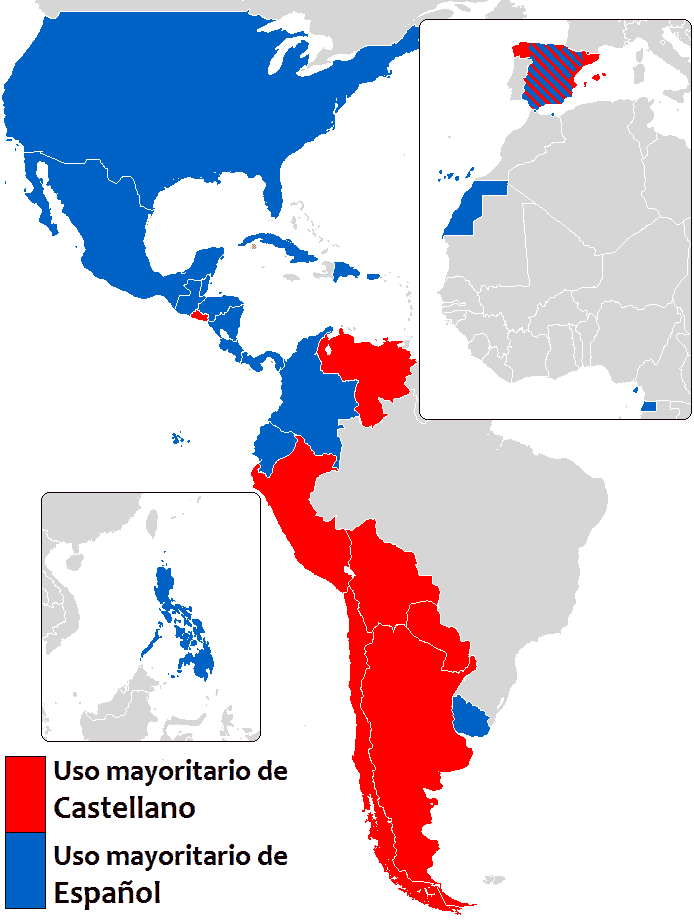
The map above shows how various “Spanish” speaking countries refer to their language. In the US. Mexico, the Caribbean, Philippines, Africa and the majority of Central America the language is known as Español (Spanish), whereas in most of South America it is known as Castellano (Castilian).
And of course to make matters more confusing it can be know by either in Span itself.
10 other facts about the “Spanish” language:
- It is estimated that over 400 million people speak Spanish making it the 2nd most widely spoken native language, behind Mandarin and just ahead of English.
- Brazilians call Spanish, espanhol.
- Spanish is the official or national language in Spain, Equatorial Guinea, and 19 countries in the Americas.
- In the European Union, Spanish is the mother tongue of 8% of the population, with an additional 7% speaking it as a second language.
- While Spanish is largely based on Latin, around 8% of its vocabulary is Arabic in origin.
- The first systematic written use of the language happened in Toledo, then capital of the Kingdom of Castile, in the 13th century.
- 13% percent of the US population over five years old speaks Spanish at home.
- Mexico is the largest Spanish speaking country with over 120 million speakers.
- The main grammatical variations between dialects of Spanish involve differing uses of pronouns.
- Spanish is one of the six official languages of the United Nations.
Prominent differences of pronunciation among dialects of Spanish include:
- the maintenance or loss of distinction between the phonemes /θ/ and /s/ (distinción vs. seseo and ceceo);
- the maintenance or loss of distinction between phonemes represented orthographically by ll and y (yeísmo);
- the maintenance of syllable-final [s] vs. its weakening to [h] (called aspiration, or more precisely debuccalization), or its loss; and
- the tendency, in areas of central Mexico and of the Andean highlands, to reduction (especially devoicing), or loss, of unstressed vowels, mainly when they are in contact with voiceless consonants.
Find this post interesting? Pleas help us by sharing it:
Mauricio Maranno says
Why Brazilians refer to Spanish as Espanhol. Of course, we speak Portuguese and Spain Ann Spanish are called Espanha and Espanhol. We do use also the name castelhano for the language. I believe that you have thought we woul speak an Spanish dialect. Please correct.
ella says
yes i agree.
David Bordon says
It is obvious that the author of this article was educated in North America due to the erroneous misinterpretation of the facts.
In Castilian language (Castellano)
Español is a male individual from Spain
Española is a female individual from Spain
Spain have several languages which include Bable, Aragones, Cantabro, Calo, Catalan, Euskera and Castellano which is the official language.
I have what will be considerate a Doctorate degree in Castilian literature from South America and Postgraduate degree form Florida International University in “Spanish Literature” (which just will equivalent to an Associate Degree in South America).
Regrettably in USA the quality of the “Spanish” teaching curriculum been used in schools is extremely deficient full of regional slang and mannerisms, usually focus in Mexican and Central American degenerations of the language (similar to the “US Ebonics slang”).
I have personally conducted Castilian literature seminar for “US Certified HS Spanish Teachers” were these Teacher were not able to even speak properly with out mispronouncing or using Mexican and Central American slang or “Espanglish” and who will not ever be consider qualified to teach the language to kindergartners outside the USA.
The map showing Spanish as official language like Colombia is insulting. In our universities when ever you taking higher literature education is always will be called Castellano only a poorly educated individual will called it Español.
Articles like this only help to spread misinformation and ignorance.
M. Lladó says
You are absolutely wrong. Español is a male individual from Spain, but is also what we call the language we speak. The people that say that they speak Castellano are mainly the Catalans and Basques, who speak Catalan and Basque (as well as Castellano) and want to break away from Spain. The main reason for calling it Castellano is that they insist that the language is not from all of Spain but imposed by Castille on the rest. The people, even in these regions, that do not want their region to break away from Spain say that they speak Español (Spanish).
albert says
Español y Castellano son dos sinónimos para la misma lengua. Si se pregunta a las personas que se autodefinen como castellanoparlantes o hispanoparlantes se puede ver que existen muy pocas diferencias anecdóticas en cuanto al lenguaje.
Srm says
“I have what will be considerate a Doctorate degree in Castilian literature from South America “. Considered by whom? Your arrogance is amazing… especially considering the errors in your post.
Pasco Loffredo says
Thank you for that comment.
Pilar Mendoza says
Yes it is they don’t know, how south American speaks the correct and proper form our language.
And Americans put all of us in the same bag
BLOPEZ says
I suggest you learn English well enough before you so atrociously use it to criticize others’ language skills. You certainly need a lot of help in writing.
Truth says
David Brandon needs to learn better English before he criticizes anybody else and their language skills.
Andrea says
It’s so interesting how tiny little El Salvador is the only country in South America that considers its language Castilian Spanish along with most of South America. I love learning about the Spanish language and the various dialects and differences varying from each country.
Andrea says
Correction I meant *central America Which is where El Salvador is hahah.